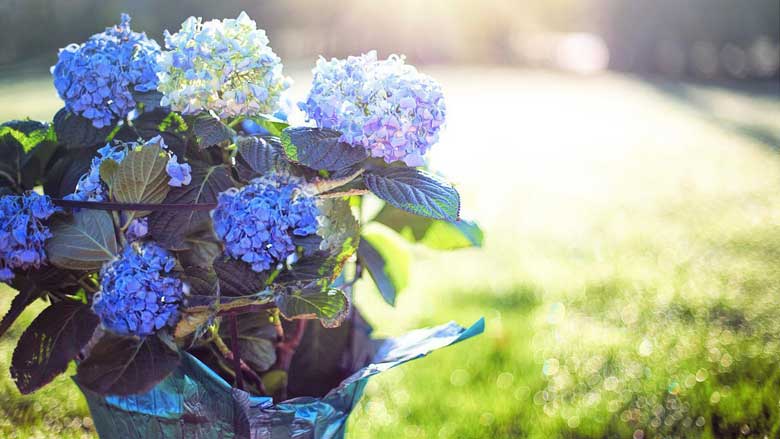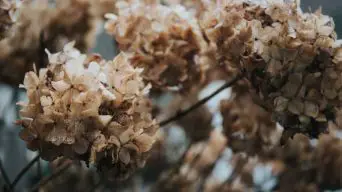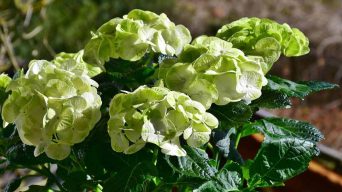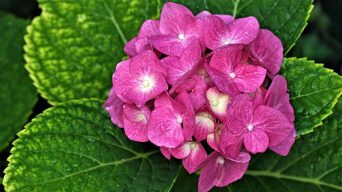Hydrangea is a popular ornamental plant grown for its large, showy flower heads.
While hydrangeas are relatively easy to care for, they can be susceptible to overwatering.
Overwatered hydrangeas will exhibit several telltale signs, including wilting leaves, yellowing leaves, and stunted growth.
Here’s what you need to know about overwatered hydrangeas, including how to identify and treat them.
What Are the Risks of Overwatering a Hydrangea Plant?
Hydrangea plants are native to moist climates and prefer evenly moist soil.
However, too much water can be as detrimental to a hydrangea as too little water.
While hydrangeas are relatively tolerant of wet conditions, overwatering can lead to several problems, including:
Fungal Growth
Overwatering can also lead to fungal diseases, such as leaf spot and powdery mildew, which can cause your plant to develop white spots on the leaves.
Fungi thrive in wet, humid conditions and can quickly spread to other plant parts.
Common fungus diseases of hydrangeas include powdery mildew, leaf spot, and stem rot.
Powdery mildew appears as a white, powdery coating on the leaves and stems of the plant.
Leaf spot is characterized by small, dark spots on the leaves.
Stem rot causes the stems of the plant to become weak and brittle.
Bacterial Growth
Bacteria also thrive in wet, humid conditions.
Bacterial diseases of hydrangeas include bacterial blight and stem rot.
Bacterial blight appears as brown or black lesions on the leaves and stems of the plant.
Stem rot causes the stems of the plant to become weak and brittle.
Pest Infestation
An overwatered plant is also more susceptible to pest infestations.
Pests, such as aphids, mealybugs, and scale, are attracted to moist conditions and can quickly damage the plant.
Aphids are small, wingless insects that feed on the sap of plants.
Mealybugs are small, white insects that feed on the sap of plants.
Scale are small, brown insects that suck the sap from plants.
Stunted Growth
Overwatering can also lead to stunted growth.
When roots are waterlogged, they cannot effectively take up water and nutrients from the soil, leading to stunted growth.
Fungi, bacteria, and pests can also damage the plant’s roots, preventing them from absorbing water and nutrients.
Stunted growth is characterized by small, stunted leaves and a slow growth rate.
How Does Overwatering a Hydrangeas Occur?
There are several ways that overwatering can occur.
The most common causes of overwatering are:
Watering Too Often
Another common cause of overwatering is watering too often.
Hydrangeas need evenly moist soil, but they must not be watered daily.
You should water your hydrangea once a week or when the top inch of soil is dry.
To test the soil’s moisture, stick your finger into the soil.
If the soil is dry up to your first knuckle, it is time to water the plant.
Use Too Much Water
When watering a hydrangea, using the right amount of water is essential.
Hydrangeas need 1-2 inches of water per week, depending on the weather.
Place a rain gauge under the plant to measure the amount of water your plant receives.
If the rain gauge measures more than 2 inches of water per week, you are overwatering the plant.
Improper Drainage
Hydrangeas need well-drained soil to thrive.
If the potting soil does not drain well, the plant’s roots can become waterlogged and begin to decay.
To test the drainage of your potting soil, pour a cup of water onto the soil and observe how long it takes for the water to drain.
If the water drains within an hour, the drainage is good.
If it takes longer than an hour, the drainage is poor, and you should consider repotting the plant in a pot with better drainage.
Using The Wrong Type of Water
Using the right type of water when watering your hydrangeas is essential.
Tap water high in chlorine and other chemicals can damage the plant’s roots and lead to stunted growth.
Instead, water your hydrangeas with rainwater or distilled water.
Chlorinated tap water can also be used, but it is best to let it sit for 24 hours before using it on the plant.
This will give the chlorine time to evaporate.
Incorrect Pot Size
Hydrangeas also need to be planted in a pot of the correct size.
If the pot is too small, the plant’s roots can become waterlogged.
If the pot is too big, the potted hydrangea can become waterlogged.
To find the correct size pot, measure the plant’s root ball and choose a pot that is 2-3 inches wider.
Too Much Humidity
Hydrangeas also need to be grown in an environment with the correct amount of humidity.
If the air is too dry, the plant will lose water faster than it can take up water from the soil.
If the air is too humid, the plant will take up water faster than it can lose water.
The ideal humidity level for hydrangeas is 50%.
You can use a humidifier or pebble tray to increase the humidity around your plant.
A pebble tray is simply a tray of water with pebbles in it.
The water will evaporate and increase the humidity around the plant.
How To Identify If Your Hydrangea Is Overwatered?
Hydrangea plants are very resilient and can withstand a lot of abuse.
However, even the most resilient plant will show signs of stress if it is overwatered.
It’s crucial to identify the signs of overwatering so that you can take corrective action.
Signs of an Overwatered Hydrangea
The following are some common signs that your hydrangea is overwatered:
1. Wilting Leaves
One of the first signs that your hydrangea is overwatered is wilting leaves.
When a plant is overwatered, the roots cannot take up water from the soil.
As a result, the plant’s leaves will begin to wilt and droop.
2. Yellowing Leaves
Another common sign of overwatering is yellowing leaves.
When the plant’s roots are soggy, they cannot take up nutrients from the soil.
As a result, the plant leaves will begin to turn yellow.
3. Browning Leaves
If the leaves of your hydrangea are browning, it is a sign that the plant is stressed.
When a plant is overwatered, the roots cannot take up water from the soil.
As a result, the plant’s leaves will turn brown and drop off because it is not getting the water it needs.
4. Soggy Soil
If the soil around your hydrangea is constantly soggy or wet, it is a sign that you are overwatering the plant.
When the plant’s roots are soggy, they cannot take up water from the soil.
As a result, the soil will remain soggy and wet.
5. Root Rot
Root rot is another common sign of overwatering.
When the roots of the plant are waterlogged, they begin to rot.
As the roots rot, they turn brown and mushy.
If you suspect your plant’s roots are rotting, it is essential to take corrective action immediately.
6. Mold
If mold grows on the leaves or stems of your hydrangea, it is a sign that the plant has been overwatered.
Mold thrives in wet and humid environments.
The leaves and stems become wet and humid as the plant is overwatered.
This provides the perfect environment for mold to grow.
7. Fungus
If you see fungus growing on the leaves or stems of your hydrangea, it is a sign that the plant is overwatered.
Fungus thrives in wet and humid environments.
The leaves and stems become wet and humid as the plant is overwatered.
This provides the perfect environment for fungus to grow.
8. Slow Growth
If you notice that your hydrangea’s growth has slowed down, it is a sign that the plant is overwatered.
When the plant’s roots are waterlogged, they cannot take up water and nutrients from the soil.
As a result, the plant’s growth is slowed down.
9. Flower Buds Falling Off
If the flower buds of your hydrangea are falling off before they can bloom, it is a sign that the plant is overwatered.
When the plant’s roots are waterlogged, they cannot take up water and nutrients from the soil.
As a result, the plant’s flower buds fall off before they have a chance to bloom.
10. Flowering Hydrangea Not Flowering
If your hydrangea is not flowering, it is a sign that the plant is overwatered.
When the plant’s roots are waterlogged, they cannot take up water and nutrients from the soil.
As a result, the plant is not able to produce flowers.
How To Save an Overwatered Hydrangea Plant
Hydrangea plants are resilient and can often be saved if they are overwatered.
If you notice that your plant is showing signs of overwatering, you must take corrective action immediately.
The following are some tips on how to save an overwatered hydrangea plant:
1. Stop Watering the Plant
The first step is to stop watering the plant.
It is essential to give the plant a chance to dry out.
If you continue to water the plant, it will only compound the problem.
Let the soil around the plant dry out completely before you water it again.
2. Allow the Soil to Dry Out
The next step is to allow the soil to dry out.
If the soil is too wet, it will not allow the plant’s roots to breathe.
As a result, the roots will begin to rot.
To allow the soil to dry out, you can either remove the plant from its pot and place it in a dry location or stop watering it.
3. Repot the Plant
If your plant’s roots are waterlogged, they will begin to rot.
To prevent this from happening, you can repot the plant.
Remove the plant from its pot and place it in a new pot with dry, fresh soil.
Use well-draining potting soil and make sure the pot has drainage holes.
4. Cut Off Dead or Damaged Roots
If your plant’s roots are waterlogged, they will begin to rot.
You can cut off the dead or damaged roots to prevent this from happening.
Carefully remove the plant from its pot and cut off any dead or damaged roots.
After cutting off the dead or damaged roots, you can repot the plant in a new pot with fresh soil.
5. Place the Plant in a Bright, Sunny Location
Once you have dried the plant, you can place it in a bright, sunny location.
The sun will help to evaporate any water remaining on the leaves and stems of the plant.
These plants need at least 6 hours of sunlight daily and thrive in bright, indirect light.
Avoid placing the plant in direct sunlight, which can scorch the leaves.
6. Water the Plant Carefully
Once you have taken steps to dry out the plant, you can begin watering it carefully.
Water the plant deeply and allow the soil to dry out completely between waterings.
Water hydrangea plants early in the day so the leaves have time to dry before nightfall.
How To Prevent Overwatering a Hydrangea Plant
Hydrangea plants are susceptible to overwatering.
To prevent your plant from being overwatered, water it carefully and only when the soil is dry.
The following are some tips on how to prevent overwatering a hydrangea plant:
1. Check the Soil Before Watering
Before you water your plant, it is vital to check the soil.
Stick your finger into the soil; it is time to water the plant if it is dry.
If the soil is wet, the plant does not need more water.
2. Use a Soil Moisture Meter
You can use a soil moisture meter to help you determine when to water your plant.
A soil moisture meter is a tool that measures the amount of water in the soil.
It is a simple and effective way to determine when your plant needs water.
3. Water Early in the Day
Water your plant early in the day so that the leaves have time to dry before nightfall.
Watering in the evening can cause the plant’s leaves to stay wet overnight, leading to fungal diseases.
4. Allow the Soil to Dry Out Between Waterings
Allowing the soil around your plant to dry out completely between waterings is crucial.
If you water your plant too often, the roots will begin to rot.
5. Use Well-Draining Soil
When potting or repotting your plant, be sure to use well-draining soil.
Soil that does not drain well can cause your plant’s roots to rot.
6. Use a Pot with Drainage Holes
When potting or repotting your plant, be sure to use a pot with drainage holes.
Pots without drainage holes can cause the roots of your plant to rot.
7. Don’t Let the Plant Sit in Water
After you water your plant, be sure to remove any water sitting in the saucer or tray.
If the plant sits in water for too long, the roots will begin to rot.
8. Avoid Overcrowding Your Plants
When you are potting or repotting your plants, avoid overcrowding them.
Overcrowded plants are more likely to be overwatered.
9. Don’t Water Too Often
One of the most common mistakes people make when watering plants is that they water too often.
Plants only need to be watered when the soil is dry.
Watering your plant more often than necessary can lead to overwatering.
10. Check Your Plants Regularly
Be sure to check your plants regularly for signs of overwatering.
If you see any of the signs listed above, take steps to dry out the plant.
Final Thoughts
Overwatering a hydrangea plant is a common problem.
However, it is a problem that can be easily prevented by following the tips listed above.
If you think your plant has been overwatered, take steps to dry out the plant and then water it carefully.
You can keep your plant healthy and prevent overwatering by following these tips.







